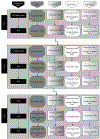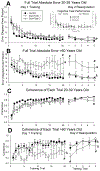Age and Cognitive Stress Influences Motor Skill Acquisition, Consolidation, and Dual-Task Effect in Humans
- PMID: 30600778
- PMCID: PMC6606407
- DOI: 10.1080/00222895.2018.1547893
Age and Cognitive Stress Influences Motor Skill Acquisition, Consolidation, and Dual-Task Effect in Humans
Abstract
This study examined motor skill learning using a weight-bearing and cognitive-motor dual-task that incorporated unexpected perturbations and measurements of cognitive function. Forty young and 24 older adults performed a single-limb weight bearing task with novel speed, resistance, and cognitive dual task conditions to assess motor skill acquisition, retention and transfer. Subjects performed a cognitive dual task: summing letters in one color/orientation (simple) or two colors/orientations (complex). Increased cognitive load diminished the rate of skill acquisition, decreased transfer to new conditions, and increased error rate during an unexpected perturbation; however, young adults had a dual-task benefit from cognitive load. Executive function predicted 80% of the variability in dual-task performance. Although initial learning of a weight-bearing cognitive-motor dual-task was poor, longer term goals of improved dual-task effect and retention emerged.
Keywords: Dual-task; aging; executive function; perturbation.
Conflict of interest statement
Figures







Similar articles
-
Over-focused? The relation between patients' inclination for conscious control and single- and dual-task motor performance after stroke.Gait Posture. 2018 May;62:206-213. doi: 10.1016/j.gaitpost.2018.03.008. Epub 2018 Mar 5. Gait Posture. 2018. PMID: 29571088
-
Table Tennis Experts Outperform Novices in a Demanding Cognitive-Motor Dual-Task Situation.J Mot Behav. 2020;52(2):204-213. doi: 10.1080/00222895.2019.1602506. Epub 2019 Apr 15. J Mot Behav. 2020. PMID: 30982463
-
Exercise Intensity Does not Modulate the Effect of Acute Exercise on Learning a Complex Whole-Body Task.Neuroscience. 2020 Feb 1;426:115-128. doi: 10.1016/j.neuroscience.2019.11.027. Epub 2019 Dec 17. Neuroscience. 2020. PMID: 31857198
-
Does sleep promote motor learning? Implications for physical rehabilitation.Phys Ther. 2009 Apr;89(4):370-83. doi: 10.2522/ptj.20080310. Epub 2009 Feb 6. Phys Ther. 2009. PMID: 19201986 Review.
-
C-SMB 2.0: Integrating over 25 years of motor sequencing research with the Discrete Sequence Production task.Psychon Bull Rev. 2024 Jun;31(3):931-978. doi: 10.3758/s13423-023-02377-0. Epub 2023 Oct 17. Psychon Bull Rev. 2024. PMID: 37848660 Free PMC article. Review.
Cited by
-
Effectiveness of Frequency-Specific Microcurrent (FSM) Therapy and Relaxation in Adults with Distress: A Pilot Randomized Controlled Trial.Healthcare (Basel). 2025 May 15;13(10):1151. doi: 10.3390/healthcare13101151. Healthcare (Basel). 2025. PMID: 40427987 Free PMC article.
-
Neuromuscular Electrical Stimulation Primes Feedback Control During a Novel Single Leg Task.J Mot Behav. 2021;53(4):409-418. doi: 10.1080/00222895.2020.1789052. Epub 2020 Jul 7. J Mot Behav. 2021. PMID: 32633214 Free PMC article.
-
Acute pain impairs retention of locomotor learning.J Neurophysiol. 2024 Apr 1;131(4):678-688. doi: 10.1152/jn.00343.2023. Epub 2024 Feb 21. J Neurophysiol. 2024. PMID: 38381551 Free PMC article. Clinical Trial.
-
Trunk Angle Modulates Feedforward and Feedback Control during Single-Limb Squatting.J Funct Morphol Kinesiol. 2021 Oct 7;6(4):82. doi: 10.3390/jfmk6040082. J Funct Morphol Kinesiol. 2021. PMID: 34698186 Free PMC article.
-
The evolution of the concept of stress and the framework of the stress system.Cell Stress. 2021 Apr 26;5(6):76-85. doi: 10.15698/cst2021.06.250. Cell Stress. 2021. PMID: 34124582 Free PMC article. Review.
References
-
- Anguera JA, Reuter-Lorenz PA, Willingham DT, & Seidler RD (2010). Contributions of spatial working memory to visuomotor learning. Journal of Cognitive Neuroscience, 22(9), 1917–1930. - PubMed
-
- Anguera JA, Reuter-Lorenz PA, Willingham DT, & Seidler RD (2011). Failure to engage spatial working memory contributes to age-related declines in visuomotor learning. Journal of Cognitive Neuroscience, 23(1), 11–25. - PubMed
-
- Assessment Center. (2017). Retrieved April 22, 2015, from www.assessmentcenter.net
Publication types
MeSH terms
Grants and funding
LinkOut - more resources
Full Text Sources
Medical
